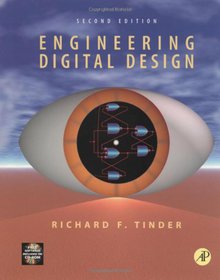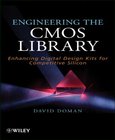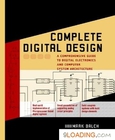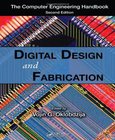Engineering Digital Design
2nd Edition

Book Details:
| Publisher: | Academic Press |
| Series: | Academic Press |
| Author: | Richard F. Tinder |
| Edition: | 2 |
| ISBN-10: | 0126912955 |
| ISBN-13: | 9780126912951 |
| Pages: | 884 |
| Published: | Jan 21 2000 |
| Posted: | Nov 19 2014 |
| Language: | English |
| Book format: | |
| Book size: | 48.26 MB |
Book Description:
Engineering Digital Design, Second Edition provides the most extensive coverage of any available textbook in digital logic and design. The new REVISED Second Edition published in September of 2002 provides 5 productivity tools free on the accompanying CD ROM. This software is also included on the Instructor's Manual CD ROM and complete instructions accompany each software program.In the REVISED Second Edition modern notation combines with state-of-the-art treatment of the most important subjects in digital design to provide the student with the background needed to enter industry or graduate study at a competitive level. Combinatorial logic design and synchronous and asynchronous sequential machine design methods are given equal weight, and new ideas and design approaches are explored. The productivity tools provided on the accompanying CD are outlined below:[1] EXL-Sim2002 logic simulator: EXL-Sim2002 is a full-featured, interactive, schematic-capture and simulation program that is ideally suited for use with the text at either the entry or advanced-level of logic design. Its many features include drag-and-drop capability, rubber banding, mixed logic and positive logic simulations, macro generation, individual and global (or randomized) delay assignments, connection features that eliminate the need for wire connections, schematic page sizing and zooming, waveform zooming and scrolling, a variety of printout capabilities, and a host of other useful features. [2] BOOZER logic minimizer: BOOZER is a software minimization tool that is recommended for use with the text. It accepts entered variable (EV) or canonical (1's and 0's) data from K-maps or truth tables, with or without don't cares, and returns an optimal or near optimal single or multi-output solution. It can handle up to 12 functions Boolean functions and as many inputs when used on modern computers. [3] ESPRESSO II logic minimizer: ESPRESSO II is another software minimization tool widely used in schools and industry. It supports advanced heuristic algorithms for minimization of two-level, multi-output Boolean functions but does not accept entered variables. It is also readily available from the University of California, Berkeley, 1986 VLSI Tools Distribution. [4] ADAM design software: ADAM (for Automated Design of Asynchronous Machines) is a very powerful productivity tool that permits the automated design of very complex asynchronous state machines, all free of timing defects. The input files are state tables for the desired state machines. The output files are given in the Berkeley format appropriate for directly programming PLAs. ADAM also allows the designer to design synchronous state machines, timing-defect-free. The options include the lumped path delay (LPD) model or NESTED CELL model for asynchronous FSM designs, and the use of D FLIP-FLOPs for synchronous FSM designs. The background for the use of ADAM is covered in Chapters 11, 14 and 16 of the REVISED 2nd Edition.[5] A-OPS design software: A-OPS (for Asynchronous One-hot Programmable Sequencers) is another very powerful productivity tool that permits the design of asynchronous and synchronous state machines by using a programmable sequencer kernel. This software generates a PLA or PAL output file (in Berkeley format) or the VHDL code for the automated timing-defect-free designs of the following: (a) Any 1-Hot programmable sequencer up to 10 states. (b) The 1-Hot design of multiple asynchronous or synchronous state machines driven by either PLDs or RAM. The input file is that of a state table for the desired state machine. This software can be used to design systems with the capability of instantly switching between several radically different controllers on a time-shared basis. The background for the use of A-OPS is covered in Chapters 13, 14 and 16 of the REVISED 2nd Edition.The above software, as bundled with the REVISED 2nd Edition, will be unique and highly useful to students and faculty alike for both instructional and research purposes. All of the above software, except the EXL-Sim2002 simulator, require the use of a text editor. A "Slideshow" and a "Software Overview" are also included on the CD ROM to provide additional information regarding these productivity tools and the many other new and unique features found in Engineering Digital Design REVISED Second Edition). Other new features found in the REVISED Second Edition include numerous new end-of-chapter problems that have been added to enrich the student's learning experience by making use of the software tools listed above. After inspecting the REVISED Second Edition and using the software bundled with it readers will find a fresh new approach to logic design and analysis has been introduced. The text is designed to be used at the entry, intermediate or advanced levels thereby making it unnecessary for students to change texts between successive courses in the subject area. * CD-ROM bundled with text includes 5 powerful productivity tools free* The most complete coverage of any text in digital logic and design* Appropriate for introductory and intermediate courses in digital logic and design* Over 670 figures and tables help to replace lengthy explanations* More than 1000 worked and unworked exercises and problems aid the learning process* Unique coverage of ALUs* Extensive coverage of number systems, binary arithmetic and codes* Exceptionally strong in synchronous and asynchronous machine design* Extensive glossary presented at the beginning of the text
Book categories:
Hardware , Programming , Software Design, Testing & Engineering , Design & Architecture , Engineering , Electrical & ElectronicsDownload Link:
Related Books:
Engineering the CMOS Library
Enhancing Digital Design Kits for Competitive Silicon
Shows readers how to gain the competitive edge in the integrated circuit marketplaceThis book offers a wholly unique perspective on the digital design kit. It points to hidden value in the safety margins of standard-cell libraries and shows design engineers and managers how to use this knowledge to beat the competition. Engineering the CMOS Library reveals step by step how the generic, foundry-provided standard-cell library is built, and how to extract value from existing std-cells and EDA tools in order to produce tighter-margined, smaller, faster, less power-hungry, and more yield-producing integrated circuits. It explores all aspects of the digital design kit, including the different views of CMOS std-cell libraries along with coverage of IO libra...
Complete Digital Design
A Comprehensive Guide to Digital Electronics and Computer System Architecture
YOUR ONE-STOP RESOURCE FOR DIGITAL SYSTEM DESIGN!The explosion in communications and embedded computing technologies has brought with it a host of new skill requirements for electrical and electronics engineers, students, and hobbyists. With engineers expected to have such diverse expertise, they need comprehensive, easy-to-understand guidance on the fundamentals of digital design.Enter McGraw-Hill's Complete Digital Design. Written by an experienced electrical engineer and networking hardware designer, this book helps you understand and navigate the interlocking components, architectures, and practices necessary to design and implement digital systems. It includes:* Real world implementation of microprocessor-based digital systems* Broad presentatio...
Digital Design and Fabrication
In response to tremendous growth and new technologies in the semiconductor industry, this volume is organized into five, information-rich sections. Digital Design and Fabrication surveys the latest advances in computer architecture and design as well as the technologies used to manufacture and test them. Featuring contributions from leading experts, the book also includes a new section on memory and storage in addition to a new chapter on nonvolatile memory technologies. Developing advanced concepts, this sharply focused book Describes new technologies that have become driving factors for the electronic industry Includes new information on semiconductor memory circuits, whose development best illustrates the phenomenal progress encountered by the...
2007 - 2021 © eBooks-IT.org



